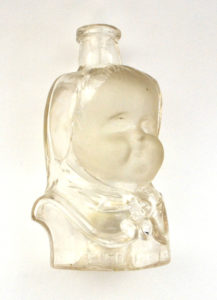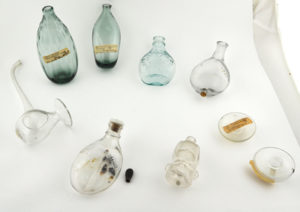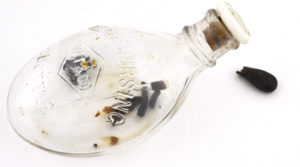By Michelle Marcella

A 19th-century baby bottle.
Behind the scenes at the Russell Museum of Medical History and Innovation at Massachusetts General Hospital, there sits a box labeled “Collection of nursing bottles, breast pumps and nipple shields.” These baby nursing supplies are similar to those of a contemporary hospital nursery except that these artifacts date to the late 19th century, when bottle feeding was a brand-new concept. The little glass bottles were meant to ease the burden of child care that Victorian mothers faced. Often sporting such whimsical names as “Feed The Baby” and “Mummie’s Darling,” the bottles were patented and introduced in the late 1800s. Although many women continued to breastfeed, bottle feeding became a way to help those mothers who were unable to breastfeed, could not afford a wet nurse, or who wanted the freedom of not having to be accessible for feeding 24 hours a day – as well as wrestling multiple times throughout the day with a restrictive corset.
The bottles worked simply. After the banjo-shaped bottle was filled with liquid, often cow or breast milk, a long rubber tube was inserted through a stopper in the bottle’s thin neck. The section of the tube outside the bottle was fitted with a rubber nipple. The shape of the bottle and the length of the tube allowed a child to hold and eat from the bottle without help, giving mothers freedom to take care of other household duties.

An array of nursing supplies, including a glass breast pump.
With this modern convenience, however, came untold tragedy. Infant mortality rates during the late Victorian era were high, with fewer than two babies of every ten surviving until two years of age. While providing sustenance, these bottles also delivered poison to many of the babies. Bacteria of all kinds flourished in the difficult-to-clean hoses, and the design of the bottles, unlike those of the more open household bottles and jars, also provided breeding grounds for molds and diseases. Even the Victorian age Martha Stewart wasn’t helpful. Isabella Beeton was a household management guru and her 1861 book, Mrs. Beeton’s Household Management, provided counsel on everything that the busy lady of the house needed to know about child rearing, and how to keep her household in tip-top shape. When it came to baby bottles, this domestic guru advised that washing nipples every two to three weeks was sufficient. Unfortunately, the impure environment of the rubber nipple allowed for even more bacteria to grow with abandon, and added to the contaminated bacteria already collecting in the bottles.

A banjo-style nursing bottle closed with a ceramic stopper, and with remnants of original rubber hose inside.
By the time Buffalo, New York outlawed the bottles in 1897, they had acquired the moniker “murder bottles.” After widespread condemnation by medical communities in the U.S. and abroad, many other cities and states followed suit. Surprisingly, however, the bottles continued to be available and popular until the 1920s as the promise of independent feeding remained appealing.
Michelle Marcella is the operations and finance manager at the Paul S. Russell, MD Museum of Medical History and Innovation at Massachusetts General Hospital.
